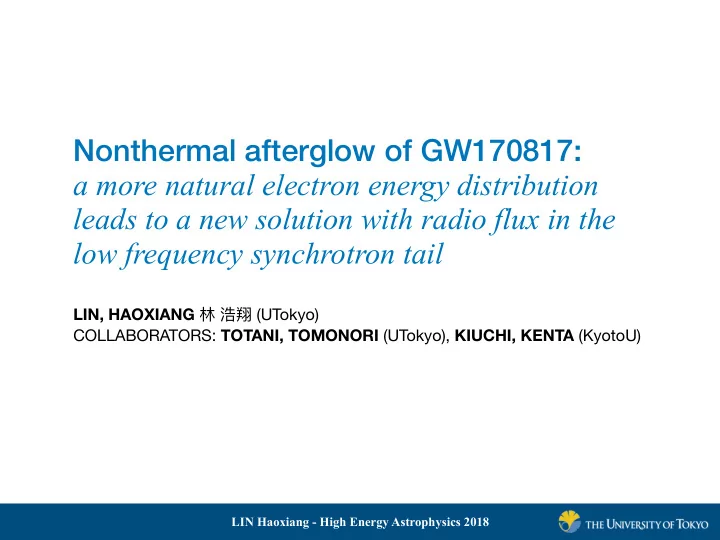

Nonthermal afterglow of GW170817: a more natural electron energy distribution leads to a new solution with radio flux in the low frequency synchrotron tail LIN, HAOXIANG 林淋 浩翔 (UTokyo) COLLABORATORS: TOTANI, TOMONORI (UTokyo), KIUCHI, KENTA (KyotoU) LIN Haoxiang - High Energy Astrophysics 2018
Nonthermal afterglow of GW170817 One-year afterglow of GW170817: • Nonthermal spectrum F ν ~ ν -0.6 : synchrotron radiation from shock-accelerated electrons (electron spectral index p ≈ 2.2 ) • Slow rising ( F ν ~ t 0.8 ), peak ~ 160d, fast decay ( F ν ~ t -2 ). Simple pictures are challenged by slow rising pattern: • Uniform jet viewed o ff -axis ( F ν ~ t 3 ) • Single-velocity spherical outflow ( F ν ~ t 3 ) • Slow rising → Gradual input of energy → more complicated outflow structure Afterglow SED of GW170817 (Troja+18) LIN Haoxiang - High Energy Astrophysics 2018
Nonthermal afterglow of GW170817 Structured jet viewed o ff -axis ( Jet , e.g. Lazzati+17, Margutti+18): • Ultra-relativistic core + slower wings • Initially beamed-away core emission gradually enters line of sight to o ff -axis observer Radially-stratified (quasi-)spherical outflow ( Sph , e.g. Mooley+18): • “Cocoon” created by a successful/chocked jet • Radially-stratified layers: fast layers traveling ahead gradually caught up by slow layers and energized “Cocoon” (Kasliwal+17) Jet Sph Obs (Alexander+, Corsi+, Mooley+, Troja+18): F ν ~ t -2 F ν ~ t -1.2 Decay rate • F ν ~ t -2 after ~ 160d • No cooling passage till ~ 360d ~ 10 4 d ~ 10 2 d Cooling passage • Not resolved by VLBI, but superluminal motion Large axial ratio, flux Spherical, small Radio imaging centroid large o ff set o ff set • ∏ < 12% (2.8 GHz) at 244d 10% – 60% < 10% Linear polarization jet-dominated late-time emission LIN Haoxiang - High Energy Astrophysics 2018
Our research * f injection e ffi ciency, i.e. number Motivation fraction of accelerated electrons Previous studies commonly apply a conventional GRB afterglow theory (e.g. Sari+, 1998, ApJ, 497, L17 ), which • assumed all electrons in the shock are accelerated ( f* = 1 ) , ignoring possible majority of thermal electrons (e.g. normally observed in SNR) • formulated in ultra-relativistic limit, but BNS merger ejecta is mildly or non-relativistic • Degeneracy in f (Eichler & Waxman, 2005) and paucity of broadband GRB afterglow data We re-examine afterglow modeling of GW170817 with a more natural electron spectrum: • f is allowed to vary freely • In conventional model, minimum electron energy γ m is controlled by other model parameters. We determine γ m independently by 1 extra d.o.f. (electron-proton coupling level) • Applicable to trans-relativistic regime We perform Markov-Chain Monte-Carlo (MCMC) analysis to estimate parameters of GW170817 LIN Haoxiang - High Energy Astrophysics 2018
Recommend
More recommend